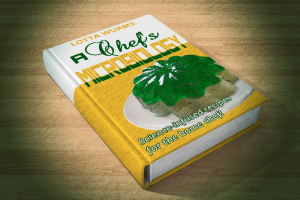Reviewed by Phil A. Minyawn
Brought to our attention by E. B. Fischadler
Art by Scarlett O’Hairdye
If you’re reading this over lunch, or even a snack, put it away until you’re done eating. For that matter, don’t read A Chef’s Microbiology by Lotta Wurms unless you need to drop a few dozen pounds; it has left me wondering if I will ever eat again. This book comes on the heels of Wurms’ other fine book on food: Digestive Forensics, in which Wurms describes how she learned that her adolescent was gorging on junk food by examining the child’s vomitus. Wurms on food is (are?) clearly suitable only for those with an iron stomach.
The book starts off innocently enough, enumerating the dozens of species of microbes that create the several varieties of green and blue cheese. Wurms soon digresses far afield when she purports to demonstrate the existence of life on the moon, specifically the microbe “Noxious Gorgonzolas,” which, she argues, converted a pleasant Camembert into the green cheese that composes the Earth’s satellite.
She returns to more familiar turf, albeit macro, not microbiology, in her discussions of biologic meat tenderizers. Reading her formula for crispy beef made me gag on a dish of rice. Wurms places a tough cut of beef with hundreds of maggots into a plastic bag that she tosses in the fridge for a few days. Over that period, the maggots eat most of the connective tissue in the meat, making it tender. Wurms also recommends this as a means to store meat without refrigeration, as the maggots prefer meat gone bad; they will eat the rancid outer layers, leaving a core of fresh meat.
The meat, maggots and all, is then roasted at 350 degrees for 30 minutes per pound. The result is a medium to well-done roast, tender inside with a crunchy outer coating. My nutritionist neighbor insists the coating has no nutrient value, but that it acts like an overdose of fiber on the digestive tract.
Wurms’ concept for the “kitchen silo” arose when she noted that some popular high-fiber digestive aids are merely fine wood fibers dissolved in water. She sets up a stovepipe on the counter, into which she tosses peels, rinds, and used toothpicks. She then “starts” the silo with an over-the-counter probiotic. After several weeks, Wurms pulls the resulting silage from the bottom of the stack, which she serves as a side dish similar to naturally fermented sauerkraut. It’s a bit hard to discriminate between Wurms’ silage and compost–both taste about the same to me. This may be an example of the fine distinctions one encounters in haute cuisine.

Several novel approaches to meats appear in Wurms’ book. Her technique of using hemorrhagic fevers to render meat free of blood and thus kosher must be employed with caution. Unless one selects a disease that can be killed by heat, the consumer will be rendered as pale as the beef.
To read the rest of this story, check out the Mad Scientist Journal: Winter 2018 collection.
Phil A. Minyawn came to culinary science with a degree in physics. He readily made the transition from nuclear fusion to fusion cuisine. His book If it Quarks Like a Duck … is based on his dissertation, Sweeping a Few Particles Under the Rug. He is also well known for his biography of Leonard McCoy, Physicist, Physician–It’s All the Same to Me. Minyawn is currently Oscar-Meyer professor of sausage and franks and is much in demand for his lecture series “you don’t know beans.”
E. B. Fischadler has been writing short stories for several years, and has recently begun publishing. His stories have appeared in Mad Scientist Journal, Bewildering Stories, eFiction, Voluted Tales, Beyond Imagination Literary Magazine, and Beyond Science Fiction. In addition to fiction, Fischadler has published over 30 papers in refereed scientific journals, as well as a chapter of a textbook on satellite engineering. When he is not writing, he pursues a career in engineering and serves his community as an EMT. Fischadler continues to write short stories and is working on a novel about a naval surgeon. You can learn more about Fischadler and access his other publications at: http://ebfischadler.wordpress.com/
Scarlett O’Hairdye is a burlesque performer, producer and artist. To learn more, visit her site at www.scarlettohairdye.com.
“A Chef’s Microbiology” is Copyright 2017 E. B. Fischadler
Art accompanying story is Copyright 2017 Scarlett O’Hairdye
